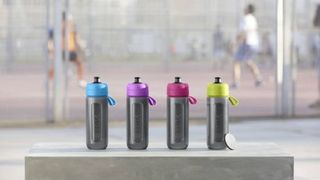Why It’s Time To Get A Water Filter
Bottles have had their day. Embrace the revolution

First things first: British tap water is safe. Really safe. If you live in the UK, you’re the beneficiary of millions of tests conducted annually to guarantee the best possible quality of water for consumers.
The current standards are taken from European legislation, which is mainly based on up-to-the-minute science from the World Health Organisation, and in 2014 test results showed that 99.96% of test samples in England and Wales, 99.89% in Scotland and 99.86% in Northern Ireland met the standards, putting UK supplies among the very best in the world.
To stay even more up-to-date, you can keep tabs on your supplier via Water UK’s tracker but as a general rule, you can rest assured that if you’re getting your H2O from the cold tap at home, work or a café, it’s certainly safe to drink.
So why get a filter? Well, safe water doesn’t always mean tasty water. For starters, water treatment plants often use chlorine to disinfect their supply and depending on the time it spends travelling to your house and where it’s sourced from, that can leave a tang. Also, the water might react with metals and rubbers in the plumbing to acquire a bitter or metallic taste.
But there’s more. Since water’s a universal solvent and dissolves a huge range of compounds, most of it contains trace amounts of minerals like calcium or magnesium. There’s also some evidence for a north/south taste divide: “soft” water, which usually comes from lakes, streams and rivers, is more common in the north of the UK and tends to contain fewer minerals than “hard” groundwater, which is what comes out of most taps in the south – with a notable difference in taste.
That might be why Londoners tend to buy more bottled water than everyone else: in 2012, a survey estimated that 37% of all water drunk in the capital was bottled. The problem? Bottled water costs 500 times as much as tap water, it isn’t as stringently regulated and a one-litre plastic bottle can take up to seven litres of water to produce.
Filtering is the third way. The most common household water filters use activated carbon to remove impurities, leaving nothing but fresh-tasting water behind. How does it work? Activated Carbon has a huge internal surface area, packed with nooks and crannies that attract and trap chemical impurities through a process called adsorption. Eventually, the filter gets gummed up by impurities (which is why it’s important to change them regularly), but it’s simple enough to change – and much more economical than buying a bottle or two of water every day.
Also worth considering is the damage that hard water is doing to your kettle or coffee machine. Some water filters contain Ion Exchange Resin which reduces the limescale that makes your kettle fur up. Save yourself some money on replacement appliances – and you’ll also notice the difference in taste in your tea (or coffee).
Drinking filtered water is easier than ever, with solutions from the traditional water filter jug, to filter taps and even water filter bottles for when you’re on the go: so there’s really no excuse. And finally, it’s possible to recycle some brands of water filters by returning them to participating shops, making them even more sustainable. The result? You’ll drink more, enjoy it more and (hopefully) do your bit to help the planet. Don’t bottle it.
Now read up on why you still aren’t drinking enough water
And find more ways to #swapforgood with the BRITA fill&go Active
Buy a BRITA fill&go Active now for just £7.99 (normally £12.99) BUY NOW
Get the Coach Newsletter
Sign up for workout ideas, training advice, reviews of the latest gear and more.
Coach is a health and fitness title. This byline is used for posting sponsored content, book extracts and the like. It is also used as a placeholder for articles published a long time ago when the original author is unclear. You can find out more about this publication and find the contact details of the editorial team on the About Us page.

